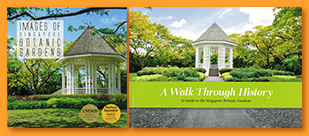Biodiversity Sanctuaries In The Sky
Did you know that in addition to our country’s lush tree-lined streets, we also have greenery above ground equivalent to that of 54 football fields?
In fact, with more and more buildings greening up their roofs and facades, we can expect that figure to increase for years to come! In the hopes of maintaining a thriving biodiversity on our island, researchers are exploring innovative methods of preserving biodiversity within the urban landscape.
Currently, a team from the National Parks Board and the National University of Singapore are gathering information to better understand if elevated greenery, such as roof gardens, could potentially provide biodiversity oases within the urban jungle and thus help to sustain wildlife species.

Researcher Vivien Lee using binoculars to observe birds on the rooftop of a building.
In order to understand how these elevated green spaces contribute to Singapore’s biodiversity, a monthly survey of 32 roof gardens was conducted across the city between May and December 2014. The study focused on animal groups that are good indicators of biodiversity at large: Birds and butterflies.

Researcher Chloe Tan recording observations on a field data sheet.
Interestingly, while the ‘usual suspects’ – such as the Javan Myna, Eurasian Tree Sparrow, Painted Jezebel and Lemon Emigrant – were the most abundant species, rare and unexpected species were also sighted. For example, a variety of Flycatcher – the Blue Rock Thrush – was observed. Birds and butterflies were found to behave in a similar manner in these elevated gardens as they would at ground level, suggesting that the elevated gardens can possibly actively support biodiversity within the city.

An Olive-backed Sunbird feeding on a banana blossom growing on a rooftop garden.

The roof garden at Khoo Teck Puat Hospital is densely planted with flowering shrubs, making it very
attractive to butterflies.
We can learn many things from this research, including structural factors of roof gardens that influence garden attractiveness to wildlife. If we are serious about maintaining biodiversity within our city, this information is vital to architects and planners of the future. Moreover, this research has noted vegetation features and selective plant species – many of which are native – that can contribute to the abundance of birds and butterflies.
Public perception studies suggest that while citizens welcomed the more aesthetically pleasing species such as butterflies, they were less pleased with the thought of caterpillars frequenting the gardens; this is a challenge as you cannot have one without the other. Educating citizens on the life-cycle of organisms and the importance of biodiversity within the city may work towards changing this perception. With the support of Singaporeans, well-designed roof gardens have a strong potential to boost biodiversity within the city.
This is an encouraging thought for the future of an increasingly urbanised Singapore.
Adapted from “Biodiversity Oases in the Urban Jungle” by Chloe Tan, Vivien Lee, Edward Webb and Jessica Bramley-Alves, which was first published in CITYGREEN issue 11
Photos by Chloe Tan and Vivien Lee





Have views or comments on this article? Let us know via this form. If you would like to give us feedback on any other areas relating to our parks and gardens, please submit via https://www.nparks.gov.sg/feedback